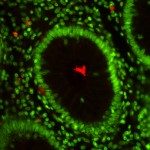Link to Pubmed [PMID] – 9695914
Microbiology (Reading, Engl.) 1998 Jul;144 ( Pt 7):1815-22
Shigellosis is characterized by a strong inflammatory response which is induced by bacteria invading the colonic mucosa. Characterization of a sepA mutant indicated that SepA, the major protein secreted by Shigella flexneri growing in laboratory media, might be involved in invasion and destruction of the host intestinal epithelium. The sequence of the first 500 residues of mature SepA (110 kDa) is homologous to that of the N-terminal region of IgA1 proteases. To investigate the potential proteolytic activity of SepA, the activity of the purified protein on a wide range of synthetic peptides was tested. SepA hydrolysed several of these substrates and the activity was inhibited by PMSF. Several peptides which were hydrolysed by SepA have been described as specific substrates for cathepsin G, a serine protease produced by polymorphonuclear leukocytes that was proposed to play a role in inflammation. However, unlike cathepsin G, SepA degraded neither fibronectin nor angiotensin I and had no effect on aggregation of human platelets. In addition, analysis of SepA hydrolysis by proteinase K suggested that the protein is composed of two domains of about 450 residues separated by a hinge region of 100 residues. The 47 kDa N-terminal domain was stable and endowed with proteolytic activity.

